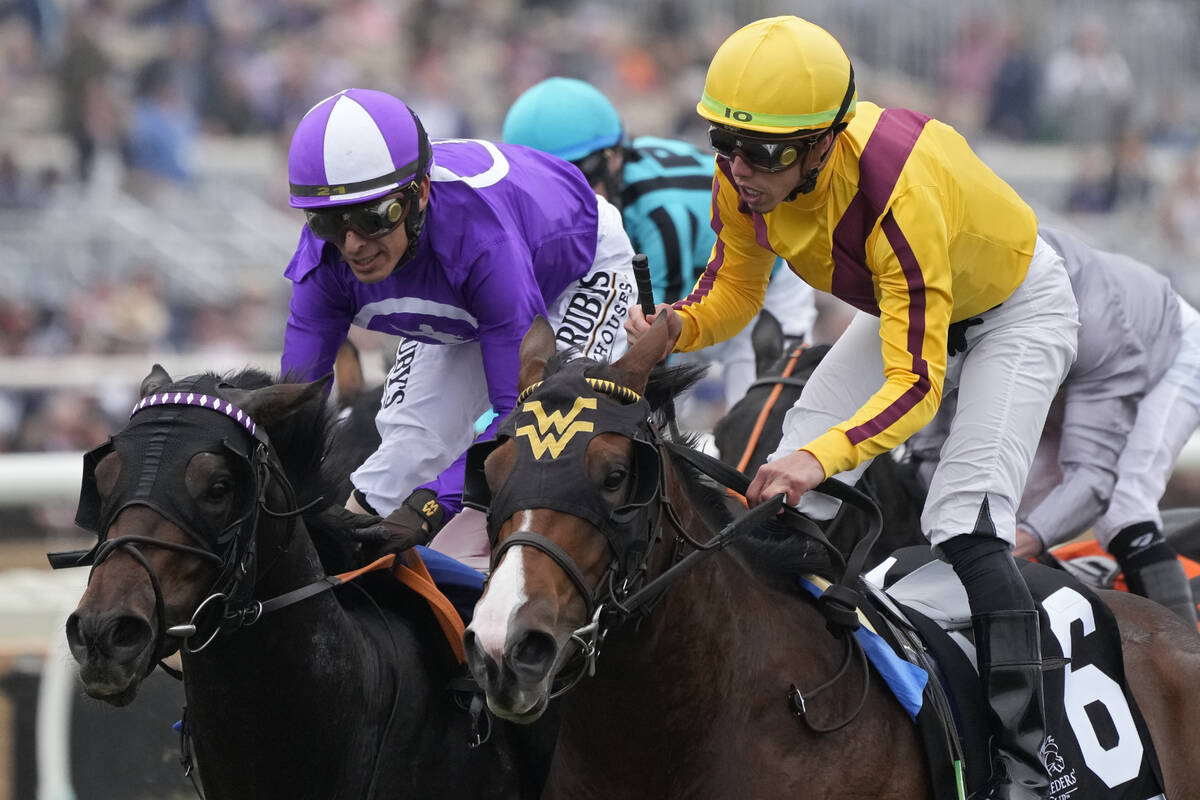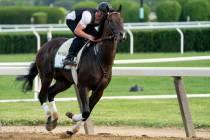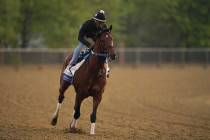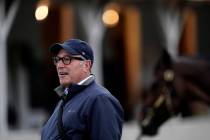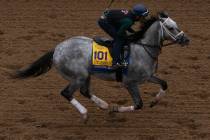Race timing technology under fire after Breeders’ Cup flub
There’s an old and completely erroneous saying in horse racing that time only matters if you’re in prison.
Just try telling that to Equibase President and Chief Operating Officer Sal Sinatra, who has been getting an earful from horseplayers infuriated by recent timing problems at Del Mar that forced the adjustment of internal fractions of three Breeders’ Cup races — the Juvenile Turf Sprint, the Turf Sprint and the Juvenile Fillies Turf. And the critics say the Del Mar issues are just the tip of the iceberg.
XBTV handicapper Jeff Siegel referred to the Del Mar race timing system this week as “thoroughly erratic and untrustworthy” in a note to his followers.
NBC Sports broadcaster Randy Moss, who’s part of the team that makes Beyer Speed Figures, posted on Twitter over the weekend that Del Mar’s new Gmax system “laid an egg on the sport’s championship day.” Moss cast the failure as predictable, given that Gmax has been plagued by problems since its U.S. launch in 2018.
“The Gmax technology does not work,” he said Wednesday on the Steve Byk’s “At the Races.” “… For whatever reasons … some of the powers that be in horse racing are loathe to admit they made a mistake.”
It was bound to happen. Del Mar's new GMax timing system laid an egg on the sport's championship day. Equibase has issued revised final times for three Breeders' Cup races - oh, and the GPS-timed fractions for the Distaff and Classic are wrong, too.
— Randy Moss (@randy_moss_TV) November 14, 2021
That’s where Sinatra, an industry veteran, comes into the picture. Having taken over in June as president and COO of Equibase, the racing industry-owned statistics database for North America, he’s immediately been thrown into a mess that’s not of his making.
The Gmax system, a joint project between Equibase and the British racing data purveyor Total Performance Data, is used by 10 tracks in North America, including Belmont Park, Pimlico, Penn National, Santa Anita and Woodbine, Sinatra told me Wednesday.
The company’s website states that the system “tracks all horses in a race and provides real-time data including speed, position, stride length, running order and timing.”
After initially trying to operate a timing system entirely via GPS, the Gmax system now uses a hybrid approach in which the starting and final times are captured using traditional “beam” technology, where a timer starts or stops when a horse passes in front of it. The internal fractions are computed using GPS readings adjusted by an algorithm, Sinatra said.
But Moss and other critics say the fractional times produced by the algorithms can be off by as much as a second from the actual time, which translates to roughly five lengths in a race. That’s a ridiculous variance that no handicapper would knowingly accept.
But Sinatra said the internal times are generally accurate and that the problems in two of the Breeders’ Cup races — the turf sprints — occurred because track workers placed a pole used to hold trackside sensors and cameras in the wrong spot, 14½ feet from the proper placing. In the other instance, the older technology failed when something — likely a horse and outrider — tripped the timer by breaking the beam.
So for now he’s focusing on process to try to eliminate such mistakes.
“Right now there are just no checks and balances. I’m trying to clean this up,” he said, adding that he understands the anger he’s hearing from data integrity defenders. “They have confidence I’m going to do it, but they’re out of patience, and rightfully so.”
He notes that the ultimate mission of the software is to produce next-generation horse racing data that can be absorbed by someone who has never looked at a Daily Racing Form.
“The whole purpose is for us to get new data to attract new blood to our sport … with the kind of analytics that other sports already have,” he said.
Of the technology’s critics, he said, “They’ll see the value of the data when we get it.”
Proposed HISA regulations unveiled
The fledgling Horseracing Integrity and Safety Authority, the new sheriff in town as far as thoroughbred racing safety and security measures are concerned, has unveiled draft regulations for public comment just over eight months before its scheduled launch.
The rules handed down by the authority, created by the watershed Horseracing Integrity and Safety Act approved last year, are intended to set uniform national horse racing medication and racetrack safety standards.
If approved by the Federal Trade Commission, they would eliminate the use of race-day medication such as Lasix, create a robust “out-of-competition” testing program, meaning horses could be tested during training or lay-ups, and strict penalties for those who violate them.
They were designed in consultation with the U.S. Anti-Doping Agency, which is expected to take on the enforcement role.
You can read the draft rules at hisaus.org.
Mike Brunker’s horse racing column appears Fridays. He can be reached at mbrunker@reviewjournal.com or 702-383-4656. Follow @mike_brunker on Twitter.
Ellis Starr's Red Smith Stakes analysis
Given there are knocks with the horses likely to be favored by bettors in this 1 3/8ths mile turf race at Aqueduct, such as Soldier Rising (GB), who has yet to win in three U.S. starts, particularly when as the 8-5 favorite last month in the Hill Prince Stakes, and with Tide of the Sea, who won the Japan Turf Cup takes in October but was beaten as the 7-5 favorite last month in the Point of Entry Stakes, I'll go with Price Talk to win this year's Red Smith Stakes. First, Price Talk is the second most lightly raced horse in the field, having run just eight times, but he's won four of those eight races, including two in a row. Price Talk won the first three races of his career, including when breaking his maiden at first asking, then breaking his maiden again after being disqualified from the first win. Last November, in only the fourth start of his career, Price Talk finished third in the Gio Ponti Stakes on the Aqueduct Turf, but when returning this spring did not run well in two races thereafter. Dropped into a claiming race in August, Price Talk won with a career-best 108 Equibase Speed Figure which was a stakes quality effort, as compared to the 109 figure Shamrocket earned winning the Point of Entry Stakes last month, the 106 figure Corelli earned winning the Singspiel Stakes in August and the 105 figure Serve the King (GB) earned when second in the Turf Classic Invitational last month. Price Talk then bettered himself with a 113 figure winning near the end of September, in what turned out to a productive race from which Shamrocket came out of to win the Point of Entry. That 113 figure is tied for the best earned by any horse in this field in 2021 with the figure Channel Cat earned winning the Man o' War Stakes in May. As such, just repeating it is good enough to win the Red Smith, but I feel he may even better that effort and figure as this will be his third start off a layoff.
Serve the King (GB) has done very little wrong in 10 career starts, like Price Talk having won four times in his career. After winning the John's Call Stakes at the longer distance of 1 5/8ths mile with a career-best 107 figure, Serve the King (GB) finished well from sixth to second in the tougher Turf Classic Invitational with a similar 105 figure effort. Irad Ortiz, Jr. was aboard for both of the horse's "A" efforts and rides back in the Red Smith, giving Serve the King (GB) a strong chance for another competitive effort good enough to win.
Shamrocket has more second place finishes (six) in his 20 race career than wins (4), and even more third place finishes (seven). Still, his win last month in the Point of Entry Stakes at 1 1/2 mile earned a career-best 109 figure competitive with the best in this field. Javier Castellano was aboard for that win, and for the colt's last win before that in June so that is a positive sign particularly as Castellano rode Value Engineering to victory last month as well as Price Talk in his two most recent wins. As such, Shamrocket rounds out a trio of horses I think stand out against the other seven in terms of their probability to win this race.
The rest of the field, with their best Equibase Speed Figures: Channel Cat (113), Corelli (106), No Word (103), Sanctuary City (107), Soldier Rising (GB) (110), Tide of the Sea (105) and Value Engineering (107).
Ellis Starr is the national racing analyst for Equibase. Visit the Equibase website for more on the race or to purchase handicapping products.



